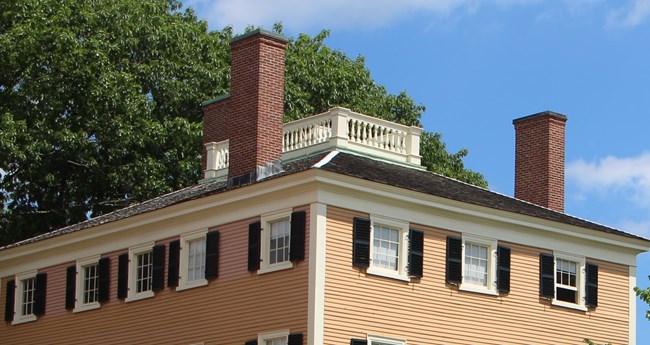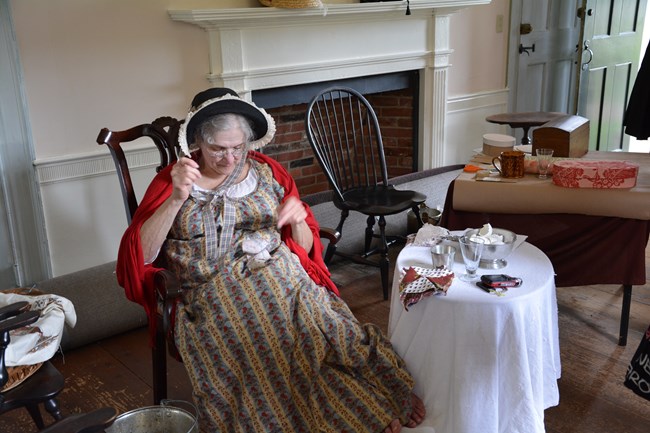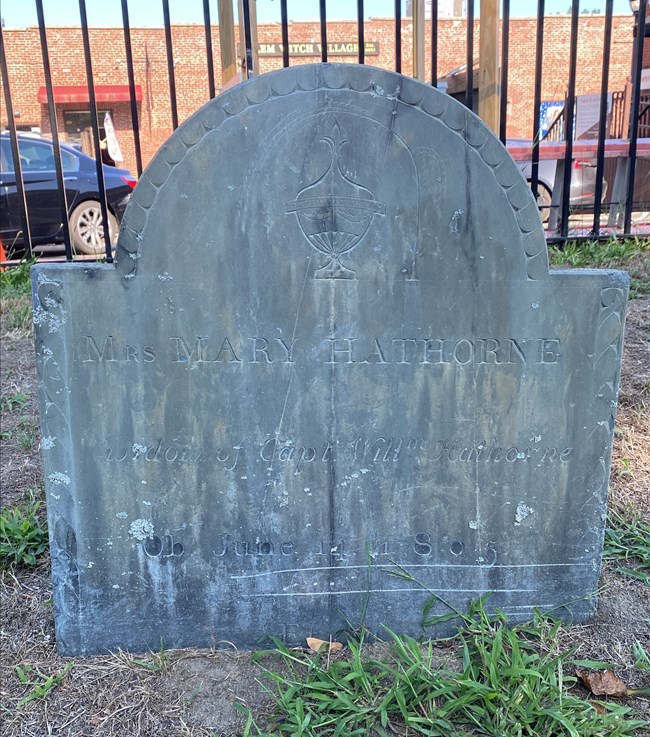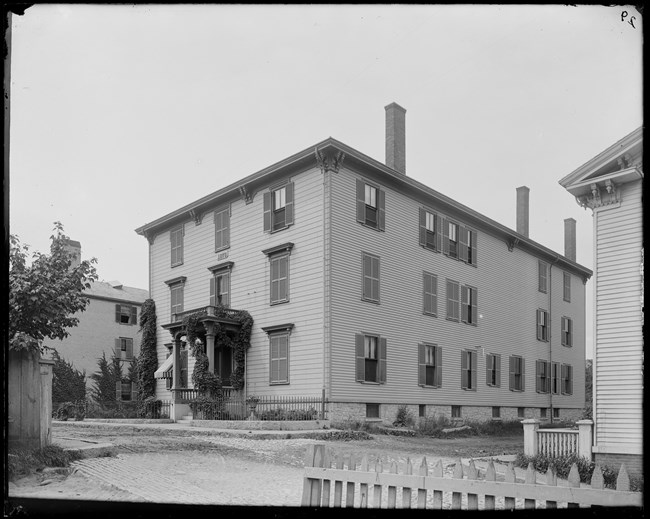Last updated: August 29, 2022
Article
Mariner Widows in Eighteenth Century Salem
Charlotte McDonald is a 2022 summer intern at Salem Maritime National Historic Site. She is studying at Salem State University working towards her bachelor’s degree in both History and Geography. Charlotte’s internship was focused on research and writing with the goal of creating an article for Salem Maritime’s website. Charlotte identified a gap in the site's "Stories" section - a lack of content on women’s history. Charlotte focused her project on seafarer’s widows in Salem during the eighteenth century. She explored local and on-line archives, literature about Salem's maritime industry, and the role of widows in New England society. This article is one result of her internship. More importantly, Charlotte inspired Salem Maritime staff to continue researching this topic.

NPS Photo / Peter Santos
Widows in Salem Society
In a society centered around a maritime economy, widows were common in eighteenth century Salem, Massachusetts. Seafaring work was dangerous and resulted in much death, not only from shipwrecks but also from disease. Since many Salem mariners were married, one can estimate their death rate according to the percent of widows within the population.[1] As reported by Salem diarist Reverend William Bentley in 1790, widows headed approximately a quarter of all households in his parish.[2]
In eighteenth century America, a law called “coverture” dictated that married women were under the legal authority of their husbands. Essentially, they were dependents and could not own property, earnings, or be guardians of their own children. They did not have a legal existence separate from their husband.[3] However, when a husband died, the widow was left in a unique position. At the death of a spouse, a widow acquired a new level of power and independence in society that they did not possess previously. Not all rights held by men were granted to widows, but they did have a level of economic autonomy that married and women who had not yet married could not.[4] A widowed woman could manage an estate, create legal documents, and bring a lawsuit to court.[5]
But widowhood did not open the door to opportunity for every woman. Apart from the grief and stress at the loss of a spouse, there was an economic downside to having your husband die and the severity of those downsides depended upon his financial standing. According to research by historian Daniel Vickers into Salem tax lists between 1690 and 1775, about 80% of women who experienced widowhood did not acquire valuable assets and independence. These women from families of a lower socioeconomic standing were often forced to move into rented rooms or become dependent on other family members.[6] Because eighteenth century society was patriarchal, it was far more common for widowed women to be forced to become dependent on another man whether that be a family member, landlord, or employer.

NPS Photo / Jeff Folger
Role of Widows in the Maritime Economy
The research Vickers did into the death rate of Salem mariners in the eighteenth century shows that it was high - slightly above 30%. Widows with sons played a unique role in sustaining Salem’s maritime economy by encouraging their sons to go out to sea.[7] Although widows were sometimes unfairly judged for heading a household (as evidenced in several literary works of the era that depict widows as lustful, incapable, and weak), if a widow had a son she was more readily accepted. If she owned property, this property would eventually be inherited by her son, so the patriarchal structure would remain intact.[8]
Sons also played an important part in the livelihood of widows by being a source of income. Due to a society largely based on women's roles centered on domesticity, women did not have many opportunities to make a livable wage on their own. They entered the job market with fewer marketable skills, connections, and less opportunity.[9] The jobs that were acceptable for women often did not earn them enough to support a family. Vickers research into Salem portledge bills from 1690-1775, shows that almost two thirds of all teenage seamen were the sons of widows. This illustrates that being a mariner was likely the primary employment option for young men who had to support their widowed mothers.[10]
Sending their sons out to sea meant that widowed women often lost one if not multiple sons. According to Reverend Bentley, between 1785 and 1819 of the 43 widows in his parish over half of them had lost a son at sea. Of these 43 widows, almost three quarters of the 32 who were under the age of 65 in 1790 had lost at least one son at sea.[11] This meant a life often stricken with grief and loss for Salem women who had both seafaring husbands and sons.
Although there was great risk in going to sea, many young men in Salem supported their families in this livelihood. A young boy might go to sea at age 12 to support his widowed mother and (if he lived long enough) may continue to do so in the support of a wife and family. One could think that the maritime economy of Salem was only as strong as the persevering widows who, while battling grief and trauma, continued to send their male family members into it. This kept seafaring men tied to Salem and stimulated the town’s economy, likely a strong component in sustaining Salem's success as a port town.[12]

NPS Photo / Charlotte McDonald
Meet Elizabeth, Abigail, and Mary
Note: To give evidence of how certain socioeconomic standing affects a widow’s place in society, this article will compare three widows. That is not to say all widows can be categorized into three different scenarios. Unfortunately, very little evidence was found written in their own words which is a result of the gendered focus of history, the archives, and long held perceptions that a woman’s value was mostly in her role as a wife and mother.
For many Salem widows, widowhood could have devastating economic impacts. If their deceased husband had not been in good financial standing, creditors sought to collect final payment for their debts. For example, Elizabeth (Whittemore) Elkin’s (1738-1780) husband, Thomas (1737-1764), was a successful ship captain who had acquired an impressive amount of property for his age - 26 years. The Elkins had a comfortable home, some farmland, and even a few livestock in Salem. However, when Thomas died, there was not enough money to pay his debts. Elizabeth had to have the house and valuables auctioned off to satisfy the demands of the creditors.[13] Although Elizabeth Elkins was fortunate in that she received a widow’s portion (1/3 of the value of her husband’s estate), she was in a much worse state than when her husband was alive. For Elizabeth, widowhood did not grant her independence or more economic opportunity. Due to the narrow opportunity women were provided during that time, she was likely forced to become dependent on another man which could have been a male family member or perhaps a new husband. The fact that Elizabeth was young made a difference in her likelihood of remarrying. In fact, Vickers found that 80% of women who lost their husbands between the ages of 35-49 did not remarry.[14]
For many black women, the opportunity for economic success after widowhood was even narrower than for white women. A well-documented example of this lies outside of Salem in Providence, Rhode Island in the case of a free black woman, Abigail (Hull) Carr (1725-unknown). While she was married to her husband, Jack Carr, her residence of Providence was not disputed. Once her husband died, and he could no longer offer financial protection, the court “warned her out” in 1787. The town was able to do this by ignoring her marriage to Jack Carr and determining her legal residence to be in South Kingston where she had been enslaved for over forty years.[15] In this case, Abigail’s status as a “former slave” and a woman of color essentially overrode her identity as a resident widow of Providence. Although this case took place outside of Salem, it demonstrates the additional prejudice Black women faced during widowhood.
Turning back to Salem, the independence widowhood provided gave some women an economic advantage. Mary (Touzel) Hathorne (1724-1805) became an “itinerant peddler” (essentially a traveling salesperson) after her husband’s death. She was able to develop an extremely successful trade network between Salem and neighboring areas. Since her business was so successful, Mary was able to provide for her family thus preventing her sons from being sent out to sea. Reverend Bentley, and potentially others in the maritime community, did not look favorably upon her and Bentley described Mary as living a “slavish gypsy life."[16] Perhaps the independence and control that widowhood provided to Mary made others in the community feel that it threatened not only the patriarchal structure of society but also the maritime economy.

7 Carpenter Street, Salem, Massachusetts
Cousins, Frank, MSS 893, Frank Cousins Collection of Glass Plate Negatives.
Courtesy of Phillips Library, Peabody Essex Museum, Salem, MA.
Benevolent Societies
Although there were avenues of support for widows in eighteenth century Salem, they were often minimal. In the nineteenth century, the Seaman’s Widow and Orphan Association of Salem was formed. The purpose of this organization was to relieve widows of some of their needs by providing them with financial aid. Over the years the organization evolved and currently it is known as “Children’s Friend and Family Services.” The organization continues to provide support to the people of Salem and surrounding towns via counseling, mentoring, and juvenile court services.[17]
Further Research
The history of widows in maritime Salem is an area lacking extensive research. Although their histories are there, the way in which archives are mined requires a lot of digging. There are many avenues for further research, such as the portrayal of widows in literature, the accusation and suspicion of widows committing crimes (witchcraft), and more on the economic pursuits of widows (innkeeping or running distilleries). It is vital to uncover this history for a more complete picture of women in Salem's maritime community. As Barry Levy, professor at the University of Massachusetts Amherst writes, “the men of Salem and other New England ports orbited around…women who they loved, feared, and abandoned. The women were the backbone of the towns.”[18]
Footnotes:
[1] Vickers, Daniel, and Vince Walsh. Young Men and the Sea: Yankee Seafarers in the Age of Sail, Yale University Press, 2007, p. 108.
[2] Barry, Levy. “Grief Management, Women, and Economic Growth in Eighteenth Century Salem Massachusetts” 2019, p. 29.
[3] Norton, Mary Beth. Liberty's Daughters The Revolutionary Experience of American Women, 1750 - 1800, Scott, Foresman & Co, Glenview, 1980, p. 46; and “Women and the Law.” Women and the Law, Harvard Business School, 2010.
[4] Norton, Mary Beth. Founding Mothers & Fathers: Gendered Power and the Forming of American Society, Vintage, New York, 1997, p. 139.
[5] Alvarez, Alyson. “A Widow's Will: Examining the Challenges of Widowhood in Early Modern England and America.” 2013, p. 8.
[6] Vickers, p. 154fn36.
[7] Vickers, p. 108.
[8] Alvarez, p. 26, 23.
[9] Herndon, Ruth Wallis. Unwelcome Americans Living on the Margin in Early New England, University of Pennsylvania Press, Philadelphia, 2010, p. 13.
[10] Vickers, p. 155.
[11] Barry, p. 33.
[12] Barry, p. 30.
[13] Vickers, p. 150.
[14] Vickers, p. 151.
[15] Herndon, p. 166.
[16] Bentley, William, et al. “Volume 3 January 1803 - December 1810.” The Diary of William Bentley: Pastor of the East Church, Salem, Massachusetts, The Essex Institute, Salem, MA, 1905, p. 195.
[17] “Seamen's Widow and Orphan Association.” Seamen's Widow and Orphan Association - SalWiki, Jan. 2013, https://www.noblenet.org/salem/wiki/index.php/Seamen%27s_Widow_and_Orphan_Association.
[18] Barry, p. 43.
